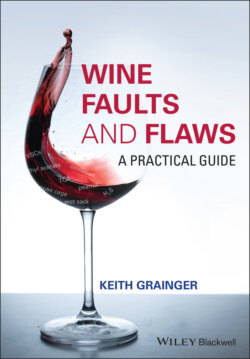Читать книгу Wine Faults and Flaws - Keith Grainger - Страница 72
2.6.3.3 Tertiary Aromas
ОглавлениеTertiary aromas result from the maturation and ageing process of the wine, particularly in bottle. During this time, there will be many chemical reactions. Following fermentation the wine will already contain some dissolved oxygen (DO), and for wines that are barrel‐matured, more oxygen will be absorbed through the cask. Provided the barrels are kept topped‐up, there will only be a small amount of beneficial oxygenation taking place, which will increase the aldehyde content of the wine. Wines matured in new barrels will absorb the greatest amount of oxygen, together with oak compounds including vanillin, lignin, and tannin. Those matured in second and third fill barrels will also pick up these, but to a lesser extent, for the pores in the wood become blocked with repeated use. Wines that are not matured in barrels may be micro‐oxygenated, and ‘oaked’ in other ways, including chips, beans, and powder.
Wine maturation in bottle results in continuous changes to the volatile compounds of the wine. At bottling time, there will be some DO in the wine, and typically some in the headspace of the bottle. This oxygen present at bottling is rapidly consumed by the wine [9]. During ageing and storage more may be absorbed from the closure itself (particularly if this is cork), through the closure depending upon type, and the interface between the closure and bottle. However, many of the changes that take place during bottle maturation are reductive. These changes take place as the oxygen content of the wine is gradually reduced. It is this process that makes bottle ageing a necessity for the maturation of many fine wines, especially full‐bodied reds. A wine that is not able to be reduced is a dead wine. However, reduced aromas are usually regarded as a fault, and this topic will be discussed in Chapter 6. As fine wines mature the tertiary aromas develop, and these can exhibit a complex array of seamless, interwoven characteristics, at best all in total harmony. Tertiary aromas are those that often evoke the most descriptive comments. Examples that might be found on red wines include shoe‐leather, Havana cigar, woodland floor, truffle, autumnal gardens, game – the list is almost endless. Tertiary aromas on white wines might include hay, honey, nuts, nutmeg, and kerosene (this might be regarded as a fault, as discussed in Chapter 15). Many vegetal characteristics that may be present in wines of any colour also belong to the tertiary group. Some of these, if present in excess, may be distinctly unpleasant.
When wines are aged beyond their projected lifespan, or suffer premature decline (perhaps due to poor storage), all of the primary and many of the secondary aromas will be lost. Of the tertiary aromas that remain, some such as caramel, toffee or soaked fruitcake may be pleasant, but many will not. The smell of rotting cabbage, stale sweat, old trainers and burnt saucepans may come to the fore, and every hint of complexity will have been drained out, rendering the wine flawed.
The descriptors for the development of the nose may range from youthful to fully developed. When desirable aromatic compounds are waning and unwelcome characteristics of a tertiary nature, e.g. rotting vegetables, are assertive, the wine may be described as tired.
Some wines go from youthful to tired without ever passing through the fully developed stage. Examples include much Beaujolais and inexpensive Valpolicella. However, there are also types of wine that are bottled fully developed, such as Sherry, Tawny Port and some sparkling wines.
